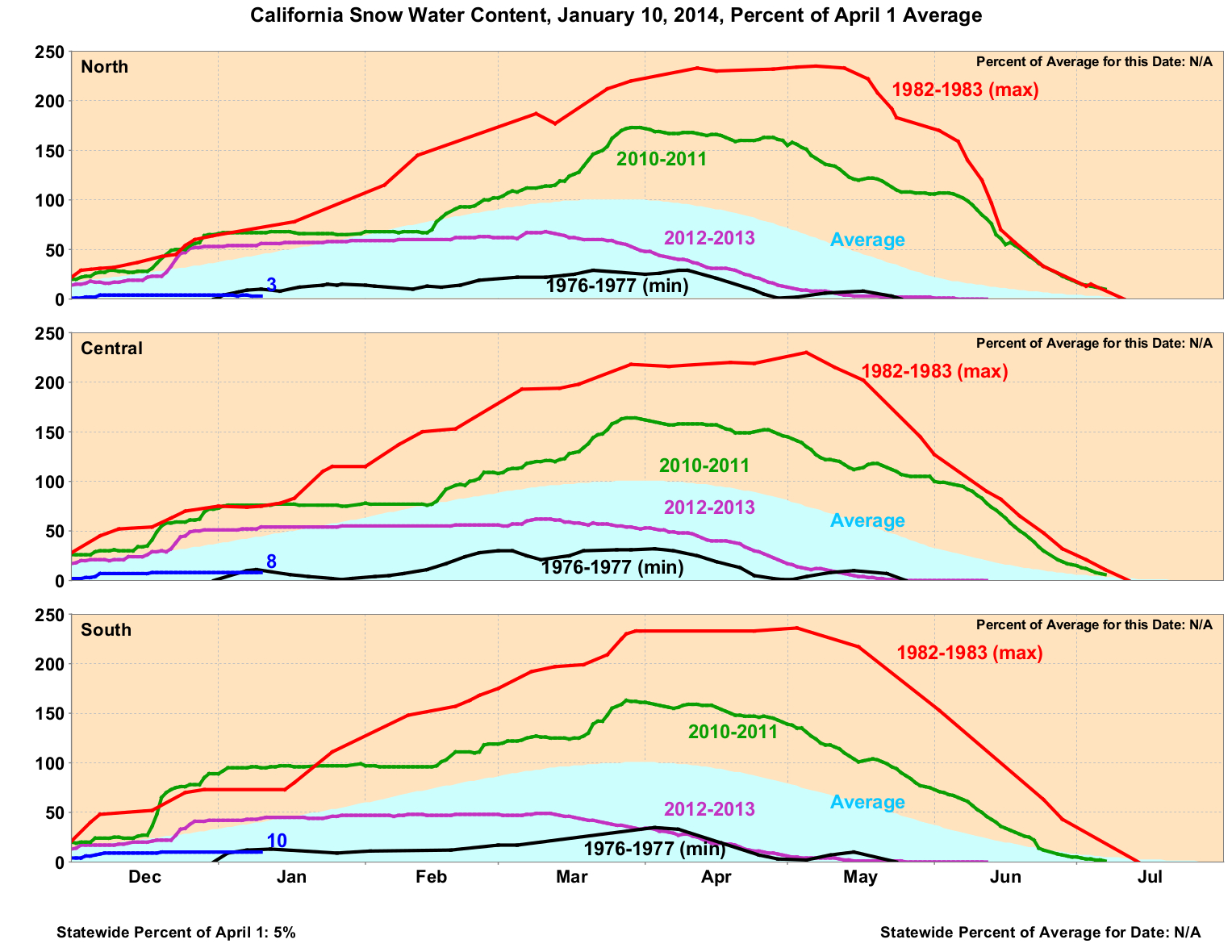The latest California drought monitor map, released on January 9, 2014, shows almost the entire state under “extreme” or “severe” drought. Much of the rest is under “moderate” drought, or termed “abnormally dry,”following a dry end to 2013.
The drought has expanded slightly since the previous map was released, amid emergency conditions in multiple areas of the state.
“Persistent ridging” has kept rain away for many in California, according to Mark Svoboda of the National Drought Mitigation Center. This term means that a mass of high pressure air--nearly four miles high and 2,000 miles long--has blocked winter storms from coming ashore in the state, deflecting them into Alaska and British Columbia, reported the San Jose Mercury News.
“It’s like the Sierra -- a mountain range just sitting off the West Coast -- only bigger,” said Bob Benjamin, a forecaster with the National Weather Service in Monterey. “This ridge is sort of a mountain in the atmosphere. In most years, it comes and goes. This year it came and didn’t go.”
This ridge is making the current drought even stronger and more persistent than a similar one during the 1976-77 drought, which was one of the driest times in the 20th century.


The worst part is, weather researchers don’t know why the ridge is so persistent, or when it’s going to go away.
“I wish I had a really good answer for this,” said Daniel Cayan, an oceanographer and atmospheric scientist with the Scripps Institution of Oceanography in La Jolla. “It’s unusual for the pattern to have not broken down to allow some relatively active, vigorous winter storm systems to track across California.”
The lack of rain is having a devastating impact from hay prices to water supplies. Last year was the driest calendar year on record in most cities in California, with records going back 160 years.
Joe Del Bosque, who farms 2,000 acres in Fresno County--a region that produces almost half of the fruits, vegetables, and nuts in America--said that he’s worried about his workers.
“Right now we’re not sure if we’re going to bring them back or how many … Crops are all in jeopardy right now,'' he told Al Jazeera. “This is the driest year in 100 years.”
He will travel to the state capitol on Thursday with other farmers to try to get Governor Jerry Brown to declare a drought emergency.
We’ve got to go up there and rattle their chains,” Del Bosque said. “We’re actively looking for water from other sources … Because of supply and demand, we could end up paying four or five times more — exorbitant.”
The water restrictions coupled with the lack of rain will likely lead to higher prices for many fruits and vegetables over the coming months.

(California Department of Water Resources)
Mandatory water restrictions are in effect in a range of cities, such as in Folson, where residents are limited to watering their lawns twice a week and have to use a shut-off valve when they wash their cars. In Santa Cruz, restaurants were ordered to serve water only on request and swimming pools can’t be drained and re-filled, as the local government aims for a 20 percent cutback in water use.
“More deterioration could be coming soon given the weather pattern, or lack thereof, and concern for water supply, fire and other impacts grows each week the rains and snows don’t come,” wrote Mark Svoboda of the National Drought Mitigation Center in an assessment that accompanied the latest drought monitor map. “In fact, many locations in California reported the calendar year 2013 as being the driest on record, smashing previous record dry years (including 1976). One such example is Shasta Dam, where only 16.89 inches was reported in 2013, more than 11 inches below the previous record low of 27.99 inches in 1976. Shasta’s calendar year average is 62.72 inches.”
Daniel Swain, a graduate student at Stanford University’s School of Earth Sciences who blogs on Weather West, wrote that right now is actually supposed to be the peak of the rainy season in California, “and each day that passes without meaningful precipitation is another day when our long-term deficits grow measurably larger.”
“A wider water crisis is still a little way down the road, but if California does not receive widespread and very substantial precipitation over the next two months, many communities (especially in the northern and central parts of the state) stand to face water shortages of a magnitude previously unseen in the modern era,” he said. “In short, there’s no relief in sight for at least the next 7-10 days, and very possibly longer than that.”





